In an e-mail headed “Distortions,” a friend and Chicago resident sent me a link to CAIR (Council on American Islamic Relations) Chicago’s ‘About Islam’ page. The plight of many Muslim women is one we’ve corresponded about before so he knew I would find this part, which he specifically pointed out to me, interesting:
What about Muslim women?
Under Islamic law, women have always had the right to own property, receive an education and otherwise take part in community life. Men and women are to be respected equally. The Islamic rules for modest dress apply to both women and men equally. (Men cannot expose certain parts of their bodies, wear gold or silk, etc.) If a particular society oppresses women, it does so in spite of Islam, not because of it.
Well that’s all right then! <— Sarcasm alert. Again. What is it about religion that always brings out that side of me? “Distortions” is the perfect word to describe this passage.
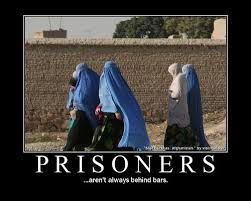 While there are Muslim-majority societies that had misogynistic cultural practices that were standard before the advent of Islam and thus Islam itself cannot be blamed for instituting them, the religion has come to support those practices. Female Genital Cutting, for example, was standard in many societies before Islam, but it is only Islam that has adopted and supported it as part of the religion. (See here.) FGC is not supported by the religions of non-Muslim societies that continue to practice it. To blame the particular society rather than the religion is disingenuous at best.
While there are Muslim-majority societies that had misogynistic cultural practices that were standard before the advent of Islam and thus Islam itself cannot be blamed for instituting them, the religion has come to support those practices. Female Genital Cutting, for example, was standard in many societies before Islam, but it is only Islam that has adopted and supported it as part of the religion. (See here.) FGC is not supported by the religions of non-Muslim societies that continue to practice it. To blame the particular society rather than the religion is disingenuous at best.
Like most religions, Islam does not treat men and women as equals. To a greater or lesser extent, women are treated as second-class citizens by religion. (In Vanuatu, women come in third – it’s pigs that are second, but that’s another story.) To me, the fact that Islam so often tries to pretend otherwise is patronizing and insulting. Just on the page linked to above, we see that CAIR Chicago apparently considers that because there are Islamic laws relating to modest dress for both men and women, this creates a situation of equality. Their definition of equality though is completely warped. It’s like saying, “Yes, we pay men and women different rates for the same job, but we pay both the legal wage rate so we are treating them equally.” This type of reasoning is common amongst religious apologists.
As the CAIR Chicago website specifically focuses on dress, I will too. In order for men and women to be treated equally, the rules applying to them must be equal, so we need to look at the rules that apply to both men and women for dress within Islam.
There are only three verses in the Qur’an that relate to clothing (via United States Muslim Women’s League):
From Yusuf Ali or Muhammad Asad translations:
Say to the believing men that they should lower their gaze and guard their modesty: that will make for greater purity for them: and God is well acquainted with all that they do.
And say to the believing women that they should lower their gaze and guard their modesty; that they should not display their zeenah (charms, or beauty and ornaments) except what (must ordinarily) appear thereof; that they should draw their khimar (veils) over their bosoms and not display their zeenah except to their husbands, their fathers …. and that they should not strike their feet so as to draw attention to their hidden zeenah (ornaments). (24:31-32)
O Prophet! Tell your wives and daughters and the believing women that they should draw over themselves their jilbab (outer garments) (when in public); this will be more conducive to their being recognized (as decent women) and not harassed. But God is indeed oft-forgiving, most merciful. (33:59)
And know that women advanced in years, who no longer feel any sexual desire incur no sin if they discard their thiyab (outer garments), provided they do not aim at a showy display of their zeenah (charms or beauty). But it is better for them to abstain (from this); and God is all-hearing, all-knowing. (24:60)
CAIR Chicago mentions the three things that men are required to consider when it comes to their clothing according to Islamic law:
Men cannot expose certain parts of their bodies, wear gold or silk, etc.
Islam.org, in their Rules related To covering, discusses all the appropriate verses from the Qur’an and the various hadithat [plural of hadith], and provides guidance to help people properly apply them to ensure they are Good Muslims. The rules for men, similar to those for women, are around not providing a sexual temptation to women who are not your wife, especially ghair mahram (women with whom it would be considered incestuous to have a sexual relationship). Silk is okay if it is just thread, smaller than the width of four fingers, or just a handkerchief, but silk clothing of any type is out. Wearing gold is also haram (forbidden), and if it is worn while praying it voids your prayers.
But this is Rules For Men, so there are a few outs:
84 – Rule: If a type of clothing is made of a mix of silk and something other than silk, then in the event that the term 100% silk can not be applied to that clothing, it is not a problem to wear it.
91 – Rule: It is not a problem to beautify or decorate one’s self with something that is gold coated, in the event that in reality it can not be considered as gold.
92 – Rule: If something is a mixture of yellow gold and another metal, and if the yellow gold has become mixed such that in reality it is no longer considered as yellow gold, then it does not have the ruling as gold.
And exceptions to the Rules For Men are taken one step further. There are two more rules relating to the wearing of gold and silk:
85 – Rule: It is not a problem to wear clothing if one is in doubt whether it is 100% silk or something else.
93 – Rule: If a man doubts whether an item is made of gold or not, then the usage of it for him is not a problem.
So anytime a man is caught wearing gold or silk he just has to say, “I didn’t know,” and all will be forgiven. There are no rules like that for women.
I don’t know about you, but If I was a man dedicated to Allah, Muhammad, and Islam, not wearing silk boxers and pure gold cuff-links wouldn’t be much of an imposition. And maybe your brain undergoes some kind of mysterious transition when you utter the words, “There is no god but God, and Muhammad is his messenger,” but whether or not a man is wearing those things makes absolutely no difference to whether I find him sexually attractive.
And so we come to men’s clothing. Islam.org records several rules relating to men’s clothing, but there is some repetition and they can be summed up by these two:
96 – Rule: Men must cover their private parts from other men and those women that are his Mahram, however it is not Wajib [obligatory] to cover the rest of their body from them.
97 – Question: Is it sufficient for a man to (only) wear swimming trunks or other types of under clothing which show the shape of the private parts, but do not show the skin, in front of others?
Answer: If there is no fear of falling into sin, then it is not a problem.
The conclusion at Islam.org is that it’s only the dangly bits that must be covered. However, men must be very careful about exposing any part of their body, even their ankles, which may tempt women into lust. They must be especially cautious if younger women may see them. They specifically state though that there is no requirement for covering the head, face or hands at any time.
Islam.org has 29 rules for men related to the wearing of gold, silk, and various clothing and as we have seen, they are not particularly onerous. For women it’s completely different; there are 43 rules just for women’s clothing, and they are extremely restrictive.
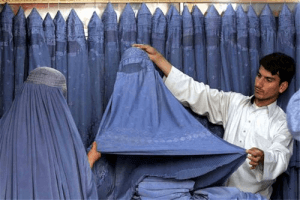
Choice, Afghanistan.
The verses from the Qur’an above are normally interpreted as women needing to wear a long, loose dress or coat with their head, hair, neck, and all parts of their body covered except their hands. Some interpretations consider a women’s face, and specifically her eyes are also part of her zeenah and therefore also needing to be hidden from all men except her husband. This is common in Afghanistan for example.
There are also interpretations that say that if a women plucks her eyebrows or wears make-up her face should be covered, if she shapes her fingernails and wears nail polish her hands should be covered, and she shouldn’t wear rings in order to beautify her hands.
Amongst the 43 rules for women’s clothing at Islam.org are these:
111 – Rule: It is not permitted for women to reveal or expose the part under the chin, the neck, the ears, the chest or the forearm up to the upper arm; and therefore one must ensure that these parts are also covered from non-Mahram men.
112 – Question: What is the extent of the Islamic hijab for women? For this purpose, does the wearing of clothing that is long and loose fitting, with pants and a scarf suffice? Essentially, what are the basics in the clothing and covering that a woman must observe in front of others?
Answer: It is wajib that the entire body of a woman, with the exception of the face and hands up to the wrist, is covered from non-Mahram men. The clothing that has been mentioned, if it covers that part which is wajib, then it is not a problem; but it is better to wear a chador.
110 – Question: According to the laws of Islam, is it allowed to expose the sole, top, malleolus and the heel of the foot, in front of non-Mahram men?
Answer: It is not allowed.
Therefore: Women are not permitted to go in front of non-Mahram men without socks on their feet, or with their feet showing, go to a nearby store to buy even just one item. Also, if there are non-Mahram men in the house, then it is not permitted to come in their presence without having socks on, even if it may be one’s husband’s brother, a sister’s husband, or any other non-Mahram men.
So in the middle of summer a Muslim man can don his Speedos and take a dip in the nearest river, lake, ocean, or pool. Women have to keep everything on, including their socks.
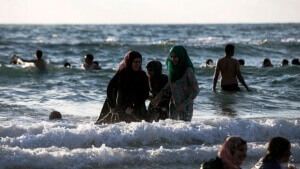
Muslim women enjoying the last day of the Eid al-Fitr holiday on a beach in Tel Aviv, July 19, 2015. Note that the men in the background are not covered. (Source: Reuters/www.haaretz.com)
In 2013 the Pew Research Center surveyed some Muslim majority countries about what was the appropriate dress for women with the following response:
There are obviously many Muslim women who don’t follow these rules, especially in the West, but the fact they even exist is a problem. If we go back to the original statement about women on the CAIR Chicago website, it included the phrase:
If a particular society oppresses women, it does so in spite of Islam, not because of it.
It’s great that there are Muslims who are working on reforming their religion, and all power to them, but Islam cannot just blame a particular society when the justifications for women wearing particular clothing rely on the Qur’an and hadithat. Like all religions, Muslims feed their children the tenets of their faith along with their mother’s milk. What behaviour is expected of women, including their dress, is part of that. The idea behind dress codes for both men and women is modesty, but the message is mainly directed at women. There are no campaigns directing men to dress more modestly, but there are multiple crusades directed at women:
The message for women is that to be a Good Muslim they are required to wear a particular type of clothing, and that it is only women who wear the prescribed dress that are deserving of respect. Their bodies are for their husbands – they are a possession of their husband and not a person in their own right. The Qur’an says, “There is no compulsion in religion,” but millions of Muslim women would disagree with that. Indeed statistics show that, a majority of women in many Muslim-majority countries accept that they should obey their husbands at all times at that he has the right to decide what she should wear.
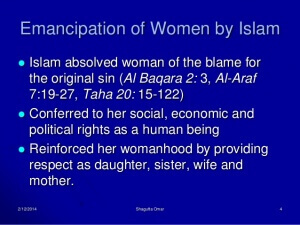 Shagufta Omar, a lecturer at the International Islamic University in Islamabad, Pakistan did, a presentation in 2014 called ‘Gender Equality in Islam.’ (See her paper ‘Marriage in Islam: Life Partnership or Discriminatory Family Set up?’ here.) To the right is one of her slides. It again shows that it’s the whole attitude towards women that is the problem. As per her second point, it’s true that Islamic law gave women rights that their sisters in Christendom either didn’t have at the time, or were taken away by Christianity. However, those rights have not changed since, and women’s rights were, and are not, equal to those of men.
Shagufta Omar, a lecturer at the International Islamic University in Islamabad, Pakistan did, a presentation in 2014 called ‘Gender Equality in Islam.’ (See her paper ‘Marriage in Islam: Life Partnership or Discriminatory Family Set up?’ here.) To the right is one of her slides. It again shows that it’s the whole attitude towards women that is the problem. As per her second point, it’s true that Islamic law gave women rights that their sisters in Christendom either didn’t have at the time, or were taken away by Christianity. However, those rights have not changed since, and women’s rights were, and are not, equal to those of men.
As we can see from the third point on the slide, womanhood was reinforced “… by providing respect as a daughter, sister, wife and mother. (My Chicago friend will be pleased Omar didn’t use the Oxford comma, but it makes me cringe!) What was reinforced was a woman’s identity as an appendage of a man, not a person in her own right. She’s not a woman, she’s a “… daughter, sister, wife and mother.”
About thirty years ago I had a look through an abandoned (Christian) cemetery at a place called Morere on the east coast of New Zealand. There was a century-old headstone that read:
Mrs John Clarke
Mother of David Clarke
I’ve never forgotten it. This woman had no identity outside of being the wife of one man and the mother of another. That is how I see many women within Islam today. They are not in a position to make their own decisions. As Omar says in her article linked to above, women are “allowed” to work as long as it doesn’t impinge on their role as wife and mother. The whole modesty of dress thing is about not providing a temptation to men and protecting women. That, of course, makes women at least partly responsible if they are raped or otherwise sexually abused. The truth is that a glimpse of elbow does not tempt a man to rape. Rape is about power, and enforcing dress codes on women is about controlling them. That makes women more vulnerable, not less. How about teaching children to respect one another, boys and girls, men and women, from earliest childhood? You do not rape people you respect.
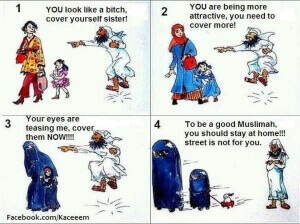
Wise words from the United States Muslim Women’s League:
Among Muslims, the division and intolerance expressed regarding women’s dress is one factor that impedes our growth and development as a meaningful presence in the world today. All Muslims struggle with matters of faith, identity, and community. With the pressing issues facing the Ummah [disapora] today such as poverty, illiteracy, violence, warfare and other ills, we must ask ourselves if we want to be consumed and paralyzed by the issue of women’s dress. Placing the burden primarily on women without calling for the accountability of men to control themselves and their sexual appetites is in violation of the spirit of the Qur’an which is about self-control and self-restraint.
In addition, the extremely negative attitudes which consider women who do not cover as somehow unchaste are most egregious and unjustifiable. Wrongful accusations against a woman’s honor are met unequivocally with severe consequences as mentioned in the Qur’an (24:4-20).
Only together, through cooperation, tolerance and forbearance, as exemplified by the Prophet (pbuh) can Muslims overcome the obstacles to success in this life and the hereafter that often are expressed in our attitudes towards women.
If you enjoyed reading this, please consider donating a dollar or two to help keep the website going. Thank you.

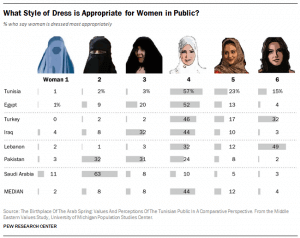


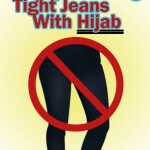

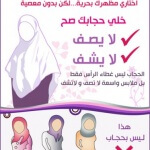
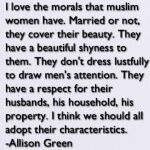

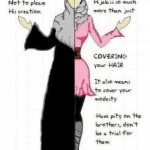

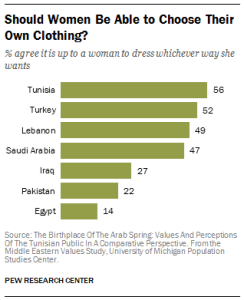
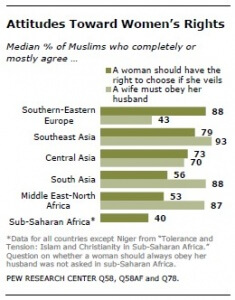
CAIR is an apologist organization for Islam. Nothing more. Any information coming from themishould be considered tainted.
Heather, cultural norms and the expectations of peers, family, employers etc dictate what people wear around the world. A Wall Street banker or corporate lawyer doesn’t go to work without the proper uniform. Can you imagine the reception an American or NZ nurse, schoolteacher, doctor or lawyer would receive if she started going to work in a full Muslim outfit (I can’t keep the various names straight)? You heard about the Professor at Wheaton College in the US who was fired for wearing a headscarf? Fashionistas are ubiquitous in the US, criticizing women for what they wear. Not so much men as long as they wear the required uniform. Again I have to ask, why the obsession with Islam when there is misogyny around the world. I posted a number of examples at your last Aue Tenei Wiki. I doubt that many Trump supporters will read your post, or those of Jerry Coyne or Sam Harris either, but if they did they would find plenty of support for banning Muslims from the US and other xenophobic Trump pronouncements. And Trump is actually less militaristic than the Islamaphobe war mongers like Cruz, who would carpet bomb them back to the Stone Age.
The “But What About” fallacy.
That might be the case GBJames if this were an isolated incident. But when professed atheists continually denounce one religion (Islam) while pretty much ignoring others (Hinduism, Judaism, Maoism, capitalism) one can conclude there is more to their agenda than they are letting on. Often what someone doesn’t say tells you more than what they do say. I know I’ll catch grief for this, but I’ll go out on a limb and speculate that partisanship for Israel is a major reason for Harris and Coyne’s focus on Islam. Hinduism may be given a pass because India too is regarded as an enemy of Islam.
Grief thrower ready, aim…. (then a flag with *Bang* on it pops out of the barrel and unfurls.)
Please consider the news of the past, oh, 15 years. Now think about which religion has largely dominated the discussion. Still wonder why Islam is the recipient of all the hate?
No one is ignoring the other religions, but we don’t hear much about Jewish or Hindu suicide bombers or large numbers of believers making threats against, well, everyone who isn’t one of them.
Maoism? Capitalism? Really? And their gods are? Right. Just stop that.
Harris & Coyne… Yup, you are definitely out on a limb there. Harris has explained his position on Israel many times. He is in no way a supporter of a ‘Jewish State’, so please again, just stop.
The last line re: Hinduism getting a pass being the enemy of Islam. Right. Apologies mate, I’m trying, but how can I possibly take that as a serious statement?
A powerful statement from General David Petreaus against rampant Islamophobia:
https://www.washingtonpost.com/opinions/david-petraeus-anti-muslim-bigotry-aids-islamist-terrorists/2016/05/12/5ab50740-16aa-11e6-924d-838753295f9a_story.html?wpmm=1&wpisrc=nl_most
“I have grown increasingly concerned about inflammatory political discourse that has become far too common both at home and abroad against Muslims and Islam, including proposals from various quarters for blanket discrimination against people on the basis of their religion.”
Heather, if you can’t read this I will copy it and send it to you.
Thanks Paxton – excellent article. (I’m not at my limit at the moment so I got it! 🙂 )
I’ve seen several other generals and senior politicians, both from the right and left, expressing similar sentiments over the last few months, clearly in response to the hate- and fear-mongering of several GOP candidates in their primary. It’s such an important issue. You and I have discussed this several times before. Basically it seems to me is that you see any criticism of Islam as feeding people like Donald Trump whereas I see it differently.
It may interest you to know that Chicago-based academic Asra Noamani, a Muslim, has contacted me directly about this post. Unlike you, she had many positive things to say about it. Dr Nomani is currently preparing a presentation which includes reference to the hypocrisy of CAIR and the double standards around dress for women in Islam. She told me she would be recommending my post to others.
My position is that Muslims are not an homogeneous group – there is as much variety of thought and ways of being a Muslim as there is in any other group. You seem to be assuming otherwise, which is exactly the way bigots like Trump and his acolytes behave. Unlike you, most people who read this post don’t see a reason for prejudice against Muslims, they see that a particular group within Islam is supporting the treatment of women as less than equal.
In NZ most of us see Muslim New Zealanders just like every other NZer – there is a wide variety and you treat them all as individuals just like you would anyone else. There’s no need to be scared of Muslims, and if at anytime you’re not sure how you should be behaving, just ask – they’re always happy to let you know just like anyone else. In fact, they usually appreciate the interest and appreciate the fact that you care enough to ask.
Our PM and other senior politicians from all sides of the House in NZ are frequently telling us that the Muslim community is our greatest ally in rooting out extremism, and I think that sort of unified leadership and appreciation is why we’ve so far had no problems in NZ. Of course, it’s easier in a smaller country too, but I think it’s an example others could follow.
A new bill introduced to Congress, which would make Donald Trump’s Muslim ban illegal: https://www.washingtonpost.com/news/acts-of-faith/wp/2016/05/11/virginia-congressmans-bill-would-make-it-illegal-for-donald-trump-to-ban-muslim-immigrants/
Looks good to me.
John Raykowski, the biggest terrorist attack by far in the past 15 years was the US/UK led invasion of Iraq, killing at least 100,000 and triggering chaos in the region that is still flaring. Maybe you missed the news that the Hindu Tamil Tigers provided the model for suicide bombing in their insurgency in Sri Lanka. Israel didn’t need to use suicide bombers in killing 2000 Gazans in 2014 because they had missiles, jet planes, and an overwhelming military advantage against which the Gazans were defenseless.
I’ll be happy to discuss Maoism and capitalism as religions with you, if you wish.
Heather, it’s true that the situation is way better here, but I can’t remember our PM saying anything like “the Muslim community is our greatest ally in rooting out extremism”. He certainly doesn’t act that way. I am aware that there are Muslim leaders who’ve complained that Key doesn’t talk to them about how to ensure the security of all kiwis. And there was the terrible example of the “jihadi brides”, a few NZ women living in Oz who traveled to places like Syria. When this was reported, the assumption made was that these women were living in NZ and were therefore being radicalised in NZ. The govt knew the whole time that this wasn’t true, but said nothing to correct the misunderstanding. Key’s policy is to support US intervention and intelligence gathering via the five eyes network and it seems likely that this was seen as too good an opportunity to put a bit of Islamic fear into the mind of the public to quell discontent at these policies. Way smaller scale than what’s going on elsewhere, but still disgusting.
I always feel like I end up being a Key apologist when we discuss NZ politics! It doesn’t exactly fit with my beliefs. 🙂
I agree Key has been far from ideal from this, but I have heard him make a statement like that, though not those exact words, on One News. At least I think it was him. There is always the possibility of course that I’m mis-remembering and it was McCully or somebody else. I remember the complaints about Key not meeting with Muslim leaders too, and the statement I remember came a few weeks after that after an effort had been made.
I must admit, I’d forgotten about the jihadi bride incident.
As you say, and I agree, the issues here are pretty minor compared to other countries. I feel like Key feels a bit guilty about Five Eyes – that most NZers would be up in arms if they knew the full extent of it, but that it’s a bit hard to get out of. So there’s a bit of justifying the action without admitting to the action going on.
I think Key completely believes in what he does and only makes political calculations about how much he can get away with. Unfortunately, our media sucks and too many kiwis are sheep, so that means he can get away with way too much.
I denounce violence against women far more often than I do violence against men. In fact, I rarely say anything about violence against men. Does this imply that I have some sort of inappropriate hidden agenda? That I just don’t care about men? Or does it imply that I simply consider violence against women to be a much more significant problem in our world today?
Professionally, I work in cancer research. I’ve never worked to find treatments for diabetes, AIDS, or the common cold. Does this imply that I am in favor of diabetes, AIDS, or the common cold? Or that I have some inappropriate hidden agenda? Or does it imply that I simply consider cancer to be a greater concern and worth the lion’s share of my focus?
Where to start? Yes, there are cultural norms amounting to obligations for dress in the West, as you say, but what are the consequences for violation of those norms? Women in the Islamic world have been f-ing murdered for not dressing properly.
Paxton, this isn’t about cultural norms but religious rules. That is the whole point of the post – CAIR is trying to pass off any bad treatment as a symptom of society and denying any responsibility for Islam. NZ doctors, lawyers, and schoolteachers do go to work in the chador (covers everything except face and hands). I’ve visited two doctors myself who were dressed like that. Nurses, of course, have a uniform, and many of the tasks they perform would be dangerous wearing a chador. Also, religious rules mean that an observant Muslim simply couldn’t perform his/her duties as a nurse. It is difficult for doctors too, but they have more control over their environment and the kind of work they do.
The professor at Wheaton wasn’t fired for wearing a hijab (headscarf), she wore full Muslim dress, and that wasn’t the reason anyway. Wheaton College specifically told her, in writing, they has no problem with her wearing a chador. All Wheaton professors are required to sign a “Statement of Faith” which apparently commits them to living twelve particular evangelical Protestant beliefs. That’s where she came a cropper. I personally find the “Statement of Faith” abhorrent, but she chose to sign it and they considered she broke it because of a Facebook post saying Christians and Muslims worship the same god. I don’t think she should be fired because what she wrote is correct – they do worship the same god. And I suspect there is a great deal of anti-Muslim sentiment in the community which probably had a lot to do with this. However, you are misrepresenting the situation by saying wearing a hijab got her fired. Here is where I got most of my understanding of the situation: http://edition.cnn.com/2016/01/13/opinions/obeidallah-college-professor-hijab/
I cannot accept your aligning of Sam Harris and Jerry Coyne with Trump. Jerry made it clear on his website that he voted for Bernie Sanders in the Illinois primary, and has always made his disgust with Trump, Cruz, and most other GOP candidates clear. He has also specifically stated he opposes the banning of Muslims. As for whether his supporters will read this post, as Jerry was kind enough to write about and link to it on Why Evolution is True today, I suspect a few of them are reading it – my traffic is higher than usual and there’s no other reason I can think of for that than a popular website referring to it.
Criticizing a religion does not mean you support bombing some of its adherents. Besides, you know perfectly well from multiple posts I’ve written and you have commented on that I don’t support the bombing of innocent Muslims, or even the torture of terrorists.
There is misogyny in most religions and I’m going to keep writing about it, and I’m not going to ignore one religion that happens to be one of the worst offenders because some ignoramus out there might use my words to support their own agenda.
Heather, I would oppose teachers or anyone serving in a public funded capacity being allowed to wear any religious garb.
I wouldn’t ask you to ignore the harm done by any religion, I was just asking why you (but even more Coyne and Harris) seem to ignore the harm done by religions and doctrines other than Islam. How could a man who has made debunking religion his major professional focus, and who writes repeated posts about the vileness of Islam and the retrograde views of most Muslims (though he says he never has known a Muslim), travel to India and not mention the terrible poverty and inequality due to the Hindu caste system? China probably executes more people than all Islamic countries combined. Where are the posts. Criticizing Islam does not make one an Islamophobe, but holding Islam to a different standard than everyone else does.
I write about what I feel like writing about on any given day. It’s not up to you or anyone else to make that decision for me. I don’t write about India and China (or South America) because I don’t know much about them and when I do write about something I like to be accurate and know what I’m talking about. I simply find Africa, the Middle East, Europe, and the US more interesting. I’m a NZer, but I’ve written heaps more about US politics than NZ politics. There are USians who think I’ve got no right to comment about that either – by a startling coincidence they’re all GOP supporters. I don’t ignore those other things at all – I find them deeply concerning. Whether I write about them or not is not a sign I don’t know about them or care about them.
I do not hold Islam to a different standard – unlike Islam, I hold everyone to the same standard.
I’ve said this before: if you want to write about things like China, you have the intelligence and ability to start your own blog. There are plenty of appalling things happening. The level of family violence, especially towards women, is a major issue there but getting information about it to write about it would be darn near impossible for a blogger in rural NZ.
I actually think it’s unreasonable to oppose anyone serving in a publicly funded capacity wearing religion garb. For a start that would gut our parliament (including MPs), government departments, and hospitals (not just schools) of all Sikhs, Muslims, Rastafarians (yes, we’ve even had a Rasta MP), and a few others. As long as they don’t proselytize on the job it’s not a problem.
Jerry Coyne ignoring the harm done by religions other than Islam? That is pertinently a falsehood and ridiculous. He opposes Christian and Jewish fundamentalism just as hard. Please get your facts right before you make such accusations.
Paxton, you’re deliberately obtuse. I have denounced the Hindu caste system before on my website, as well as the pernicious practices of Judaism, Catholicism, and Christianity. It so happens that I find Islam the most oppressive and dangerous of faiths, and so if I write more about it, that’s the reason. But to claim that I’ve ignored other faiths is just wrong, and I’d like an apology (of course I won’t get one).
Finally, as others have noted, your whole argument, “you have to pay attention to everything if you call out one thing”, is bogus. Do you criticize those in Habitat for Humanity who build houses for the poor, but only in America? Do you criticize those who decry Assad in Syria because they don’t criticize Kim Jong-un?
I haven’t criticized North Korea much, although I have written about it. Does that make me an Islamophobe? I reject that label, and call you out as an apologist for the bad acts fostered by Islam. For you, it seems, if you can’t criticize every evil in the world, you should shut up about them all.
You’re ridiculous.
Jerry, I have great respect for your writings on evolution. As a respected scholar in a fine university, your judgments on biological matters have considerable credibility. I trust that in your experimental work you control for confounding effects wherever possible, and where not possible you use statistical methods to isolate the effect of one variable from another. You identify and discuss alternative explanations and base your conclusions on solid data. Thus when you wrote recently about the relative role of transcription factors and RNAs, vs. epigenetic markers and histones in gene regulation, a question about which I am unable to make an informed decision, I felt I had good reason to trust your judgment.
I am also an atheist of long standing, and although I do not believe that all religious influences are as uniformly harmful as you seem to think, I am entirely with you in rejecting supernatural explanations for physical phenomena, and supernatural authority for moral decision making.
However, I find your religious analysis to be oddly lacking in the careful objectivity you bring to your science. Take for example your statement above: “It so happens that I find Islam the most oppressive and dangerous of faiths.” Is this based on careful historical, comparative, and where possible, quantitative analysis of the oppressiveness and danger of different faiths? You have written multiple times on Charlie Hebdo and other “Islamist” terrorism, but have you ever compared this with the terrorism the US/UK inflicted on defenseless Iraqis, or Israel inflicted on defenseless Gazans? Did the thousands of innocent people who died and were injured in those attacks suffer any less than the dozens who died in Paris and Brussels? There are data available on numbers of people killed and injured, but you don’t use them. You dismiss out of hand claims that Muslim terrorism is a response to western imperialism but have you really considered the almost continuous western meddling in the middle east, from the Sykes-Picot agreement by which the Brits and French divided up the remnants of the Ottoman Empire, to the numerous examples of overthrowing elected governments and subjecting the people to our choice of dictators?
You assert over and over the role of Islam in motivating terrorist attacks, but have you ever examined the role of Christianity in the Bush/Blair decision to invade Iraq, or in their fear mongering propaganda to whip up support for that decision? Certainly the support of evangelical Christians in the public and in the military played no small role in enabling the invasion. Yes, you criticize Christians and Jews also, but not with the same apocalyptic tone you reserve for Islam. You criticize religious Jews for refusing to sit next to women, but when have you criticized the religious Zionists who are driving the settlement movement that is such a barrier to peace. It is this lack of balance and objectivity that undermines the credibility of your religious analysis. As Heather says, she and you may write about whatever you feel like writing about. But in my reading of your work, you have sacrificed your objectivity on the altar of partisanship.
I guess that whether I apologize (for claiming that you ignore other faiths) was long ago determined (when?, at the big bang?) but I will note that I said “seems to ignore”. I will further qualify my statement by saying that you do not subject other faiths to the same level of scrutiny to which you subject Islam. If you show me this claim is false, I will apologize. I will not ask you to apologize for calling me “deliberately obtuse”, “ridiculous”, and an “apologist for the bad acts fostered by Islam”, even though the latter is demonstrably false. I have no love for Islam and only try to provide some perspective on the evils so commonly attributed to Islam because of the dangerous Islamophobia in America supporting more military action against Muslim states. This has been tried for 100 years and only made matters worse. Hitchens supported the disastrous Iraq invasion, and Harris has been ambiguous about what he would support, while being forthright in his apocalyptic warnings of the threat of Islam to the west. Like it or not, this plays into the hands of the warmongers. Fifty years ago it was the Soviet Union and international communism that was widely regarded as the most oppressive and dangerous of faiths. Fifty years from now it may well be China and Confucio-Maoism. No Islamic state or organization has anything like the ability of Russia or China have, or Hitler had, to be a threat to the west. You don’t have to “criticize every evil in the world” but a comparative and historical perspective can be useful. And the same kind of evidence-based objectivity you bring to your science.
Islam receives more criticism than most other religions because it has oppressed women, among others, far more egregiously than the rest. No other religion kills so many for perceived slights against it. No other religion is so intolerant and violent toward those who criticise it. No surprise, then, that it attracts critical comment. No normal person would expect to exercise discrimination and control over women without being denounced so why should religion give a pass to abusers of women?
I think this is part of the problem. Paxton wrote to Jerry, “I do not believe that all religious influences are as uniformly harmful as you seem to think.” Religious influences are not “uniformly harmful,” and some need to be pushed back on more than others. As you point out, conservative Islam is particularly egregious when it comes to the treatment of women.
Islam also stands out because in many countries it’s not just a religion but a political system and a legal system. Pakistan can’t pass laws protecting children from abuse because Islamic advisors say they’re heretical. Saudi Arabia, which I’ve written about several times, doesn’t even have a legal code as we understand it. All judges are experts in Islamic law and they make their own judgments depending on their own interpretation of the Qur’an.
As a long-time subscriber, which I appreciate, Paxton knows that I have criticized other religions besides Islam. Recently, I written more about that religion than any other. I would like to point out though that my main focus in these issues is not so much the religious one (though as New Atheist I obviously oppose religion) but from a feminist point of view, and simply one of fairness. As Paxton and I have discussed before, it makes me sad that so many women are forced to live a life they wouldn’t choose for themselves.
It is pretty sad to see in 2016 the lack of gender equality in so much of the world. Every week or so I see a news story about a woman being stoned to death for inflicting shame or some other minor crime. It is quite a relief to realize that Western countries generally have overcome much of the discrimination. To put all this into a broader perspective, I have to wonder how long ago the most egalitarian cultures were in a state comparable to the Islamic countries of today. I’m not really familiar with how women were treated in historic times – Roman, Asian, northern European? I suspect, however, that women were not treated particularly well throughout history. The biggest change has come from, I suspect, the advancement of legal systems and democratization that occurred over the last few hundred years. Slavery persisted in the West until the 19th century. In the U.K. and the U.S., women’s suffrage came about only in the early 20th century. Western dress codes for women were pretty conservative prior to that time as well. The bikini was invented in 1946. Olivier Saillard said, “The emancipation of swimwear has always been linked to the emancipation of women”. Anyone for a game of beach volleyball?
Of coarse in the Middle East the history of female emancipation has had to deal with the history of nomadic herding culture which spawned a very conservative religion based on male control of scarce property – cattle (and women). The rule of law which goes back centuries in Europe must have depended on stable populations in cities and the development of independent legal systems. Egalitarianism became important only when this legal stability had been in place for generations. This long phase of development must have bypassed the Islamic cultures, leading to our present situation in which law and democracy have not fully taken root. They remain in the “warlord phase” of cultural development(Taliban/ISIS). The effect of contact between Western and Islamic cultures would, at first, seem to be a quick way to modernization and gender equality. But as we’ve seen, advances have been met with a strong conservative reaction and retrenchment in many parts of the world. It is often said that these violent reactions must be the death throws of a dying worldview. Let us hope that that is the case.
I don’t know the history of women in the whole world, but in the West, Christianity meant a backward step for women. Of course, men being generally physically stronger than women meant they dominated, but there were always women who could match them and did. With Christianity came the idea that men were supposed to be in charge – that this was God’s law. Thus women were pushed back. There were still women who managed to do remarkable things, but they exclusively did so from the upper echelons of society. (Even those who did it via the Church were from the nobility.) As Christianity became stronger, women were pushed further down. Protestantism meant a small advancement for women as it had such a focus on the work ethic and hardworking women began to be appreciated wherever they were.
Women in NZ got the vote long before anyone else (1893). Australia was next. I think that that had a lot to do with the countries being so recently settled and the women worked just as hard as the men to establish things, and men simply couldn’t deny that they weren’t capable (though of course some still did and still do). A majority of NZ’s earliest European settlers too were Highland Scots who had always had a strong tradition of education for girls as well as boys.
I also think the violent reactions of many conservatives to modernization is a sign that those ideas and attitudes are in their death throes. As you know, I watch a lot of Fox News, and the level of denial to some ideas from obviously intelligent people can be quite remarkable. It’s not just that they disagree with an alternative point of view, they insist it doesn’t even exist and to think that (e.g. Climate Change) is just stupid. Evidence means nothing. I’ve even heard one of them scoffing at Evolution, though the looks she was getting from her co-presenters showed she was in a minority with that one.
Heather, although I’m sure that Christianity was not ‘good for women’ in the ‘West’, I doubt if it really was a step backward. Be it the ancient Greeks , Romans, Celts or Germanic tribes, none of them considered women as equal to men. Eg. a German gambler could gamble his wife away: chattel.
Women’s rights are a phenomenon of the Western, post Enlightenment and post Industrial revolution society. These rights were not gained easily, but only after a prolonged struggle over hearts and minds. The immigration of massive numbers of muslims, predominantly fundamentalist (or close to it) into Europe, having support from the regressive left and wolves in sheep tuxedos (thanks RD) like CAIR, is something really worrying.
The point is, fundamentalism in Christianity and Judaism -and hopefully even in the ‘left’, where it described as ‘regressive’- is close to a fringe phenomenon, while in Islam it appease to be close to mainstream.
appears, not appear. It appears the spellcheck appeases to the appeasement.
Sorry Nicky, I should have been clearer. I’m not saying women were ever equal to men, just that Christianity made things even worse, especially as it grew in strength. For example, 1500 years ago women in Ireland could have just about any career they wanted and could be equally recognized in careers like lawyers and judges as men, but they lost that as Catholicism took over.
At the same time, women were able to be bishops in the Catholic Church. In Ireland it was common for monks and nuns to marry one another and bring up their children within joint monasteries in the service of God.
Until about 1,000 it was common for Catholic priests, who by then were all men, to be married though by that time it was frowned upon. For lower level clergy celibacy wasn’t enforced though until about 1,200. At that time their wives became housekeepers and it was a while until celibacy became the norm.
In England, Ireland, Scotland, Wales, and parts of France there were many great monasteries that were joint houses. That is they had both monks and nuns (who lived separately but worked together for the glory of God) and it was almost always a woman who was in charge. These establishments were huge and managing them was a remarkable feat in any era. As Catholicism became more powerful is gradually forced women further down the scale and the joint houses either became single-sex or were run by men.
The relative power of women in the early Catholic Church is something that they like to keep quiet nowadays. There’s the obvious argument that if women could be priests and bishops 1,700 years ago and much closer to the time of Christ when the Church was purer, why can’t they now?
Ha! Yes, Faux News is really a farce on square wheels. An addictive clown car I haven’t watched for some years now. It’s good that someone is making the sacrifice…for the record.
Rickflick, I think it safe to say that women have had a subordinate status, and most have been oppressed in every society known to history before 1893 and they are disadvantaged in some ways in every current society. It is also highly likely that in all societies before the 20th century, most people would favor the Muslim dress codes mentioned above over what they would see on western beaches or even streets.
Human history is filled with inhumanity. The abolition of slavery and the emancipation of women were giant fundamental steps toward the goal of human equality. But these were legal changes of status and most societies have yet to digest the full implications. Among other things, Trump represents a male backlash against the increasing standing of women in all areas of American life. Europe is maybe ahead of the US, but the old male authoritarianism is evident in the rise of the right wing parties. In most of the world women do not have full legal equality, and even where they do, opportunities are often far from equal. Were is the evidence to single out Islam as an outlier? Is there evidence that more women are killed by domestic violence in Muslim countries than in the China or India or Africa or South America or the west?
Islam is not necessarily the fundamental problem for women’s rights. I think it has as much to do with the way human biology and culture have evolved in most parts of the world. There can be areas in India where Hindu societies are pretty much as brutal and repressive as in Saudi Arabia and Northern Afghanistan. Remember that if a husband dies in India, traditionally, the wife is incinerated along with the body of the man. The fact that Islam has garnered so much attention is because it is impinging on Western civilization. The Middle East is oil rich and Western involvement has brought modern and first century civilizations close together. 9/11 and the Paris massacres are just a symptom of a serious conflict of civilizations. Some Hindu villages may be frighteningly oppressive, but they are simply not on the radar of Western nations.
Islam, is seems to me, is something of a time capsule. It codified the level of civilization in the 7th century Middle East and preserved it as if in moth balls until the East and West began to interact in the 20th century. Now we have a walking, talking zombie in our midst. A mummified reflection of how many civilizations started out millennia ago. Muslims are confined in their sacred promises and rituals and prevented from accepting enlightenment values, so hard won by the rest of us. This is where the emphasis on Islam occurs. If Hindus or Maoists or Buddhists were sending suicide bombers into subways and on airplanes, they would be the focus of our wrath. Breaking the spell of religion is one aspect of the fight to preserve and extend modern values.
On the other hand, it might be useful if you would explain why you thing Buddhism is as sever a threat to women’s rights worldwide as Islam is today.
Islam does not have a unique hold on authoritarianism but it has a combination of features which give it a unique place in the current state of the world.
1 – It is dogmatic. History tells us that nearly all idea-sets that seek to overlook current misery for a greater future end up causing atrocities. I’m thinking of Marxism, Maoism, National Socialism, Christianity, Islam, etc.
2 – It is expansionist. Just as national socialism, Christianity and communism were seen as threats when they each appeared to be set on spreading their message throughout the world through force of arms, Islam currently appears much more set on expansionism than any of the other idea-sets you mention.
3 – It appears immune to enlightenment. You mention China as a society which should be criticised for its treatment of its population. I fully agree it is worthy of criticism, but there are signs of progression and of emancipation (compare today’s China with 1960’s China or even 1990’s China). Historically, trade has been correlated with spread of ideas and with the cessation of wars and violence and trade between China and the west has never been greater. The educated middle classes in China are on the rise and again, historically, this has been correlated with progressive ideas taking root. I see no such glimmer of hope in Saudi Arabia and I see Islam as the poison in the soil.
Where is the evidence that Islam is being singled out as an outlier? The people you mention are equally scathing in their criticism of other religions and their offences against women but the fact is Islam is more pervasive and widespread in its oppression of women than any other religion or belief system existent in the world and consequently is bound to attract more comment. Making excuses for the offences of Islam does nothing to promote the rights of women in any other society or religion and I can only question your motives for doing so. The fact is that all religions are oppressive to one section of society or another and the world would be better off without any of them.
Wonderful article. Sad that religion has placed such restrictions on women. Wonder when and if it will change.
Thanks Lee. There are people within Islam trying to change it. Sadly, most of them suffer a lot of abuse for not toeing the line. I think it will come though it may take some time.
Heather, excellent post and comments! And rickflick, your analyses and historical overview are superb.
What a snide, insulting thing to say. We love Heather’s posts.
Show me an example of Jerry or Sam ever advocating that. You might find a commenter now and then suggesting that, but the majority of WEIT commenters find that accusation contemptuous.
What the West is learning, primarily from what has gone on in Europe, is that part of our democratic values will have to consist of requiring that immigrants embrace those values that pertain to how to live peacefully with one another and abandon values and traditions that promote misogyny and sedition.
Diane, I love Heather’s posts also. The snide insult was directed at Trump supporters who are mostly too ignorant and lazy to ever read well-documented, closely argued posts like Heathers’. Harris may not have advocated banning Muslims from the US but he thinks they should be spotlighted and singled out for suspicion. Coyne often uses the Pew poll that Heather used above to demonstrate the retrograde, dangerous views of Muslims. I think Trump could use this to support his arguments. Don’t you?
Every wave of immigrants to the US has been accused of violence and criminality. Irish, Germans, Jews, Italians, Eastern Eoropeans, Hispanics, all in there turn have been castigated for holding on to their native language and values and failing to Americanize. But all have done so in time. People can’t abandon the cultures they grew up in overnight. It usually takes several generations. There is much wrong with the US, but we are far more diverse than any European country, and though there are certainly tensions, often whipped up by nihilists like Trump, Europe might learn from us also.
Sorry to butt in on your conversation with Diane, but the fact that a statistic can be used by someone like Trump doesn’t mean we should ignore it. Decisions should be based on quality information, and the statistics provided by Pew are quality information.
The US isn’t quite as diverse as USians believe, but it is true that Europe could learn from the US – you are much better at absorbing different cultures than they are. NZ is quite a lot more diverse than the US and we’re also good at absorbing and celebrating different cultures which I think is a reason that although I can’t claim there’s no racism here (there is), there’s a lot less than I’ve seen just about everywhere else.
A$$holes like Trump destroy your reputation though. Even many of his supporters don’t like the bigotry he displays, and he is doing enormous damage when it comes to making anybody who might be vulnerable to radicalism feeling alienated. I don’t believe he will be president, but he will leave a deep wound on the country that will take a while to heal and leave an ugly scar.
Your comments are never butt-ins, Heather. Diana and I may need a mediator. 🙂 Not, really, I enjoy discussing with Diane as well as with your other commenters. If we all agreed on everything it would be a pretty boring conversation.
But I’m not convinced of the quality of the Pew polls. I know Pew is a respected organization, but polling, even in a single country at a single instant of time, is notoriously tricky, depending on the specific wording of the question, who is asking it, the setting in which it is being asked. To claim to derive comparable information from so many countries is a stretch. I would like to know more about the sample size, the margin or error, and the steps taken to assure comparability of results in different countries. Were the questions asked by native speaking Muslims or foreigners? Yes these are data to be considered, but data on opinions is very different from data on behaviors.
Well, the sentence of yours that I was addressing certainly appears to me to lump Trump supporters with Coyne/Harris readers. Surely you realize that those are two non-overlapping sets.
Sadly, the regressive left of today not only doesn’t castigate immigrants for “holding on to their native…values,” it practically insists that they do just that! It’s pretty clear to me that allowing certain areas to enforce Sharia law, even tolerating the presence of “no-go” zones, is wholly incompatible with Western values.
That was my point Diane, that the two groups were non-overlapping sets and Trump supporters are probably largely unaware of what Harris, Coyne and Heather write. But I still claim that Trump supporters could get some good arrows for their quiver by reading their criticism of Islam, and especially Harris’ apocalyptic rhetoric.
I’m not aware of Shariah law or no-go zones in the US. Are these in NZ? Of course I’m opposed to both of these. What “regressive” leftists are advocating for them?
There a no no-go zones in NZ.
The fact that an anti-Muslim bigot could use something I write to attack Muslims is not a reason for me not to write it. I can’t let someone else’s ignorance silence me. I understand your concern for people who are being treated badly by many, and it comes from a good place. However, there are plenty of places for bigots to get information whether or not I write.
A lot of what they say is ignorant, made up, or misinterpreted. I always try to provide a fair and accurate assessment and I hope if they read my stuff they might be educated and it might help them realize that they can’t tar all Muslims with the extremist or terrorist brush. Such generalizations are simply wrong. I firmly believe that part of the problem is that people just don’t know much about Muslims, and the majority of what they see in the media is the worst of Islam. It’s like if the only thing we ever knew about Catholics was the stuff related to child abuse. As atheists we don’t have huge sympathy for religion anyway, but we have all known and loved many good people who are Catholics all our lives; most of us can’t say the same about Muslims. I think knowledge of some of the issues ordinary Muslims talk and think about everyday, in this case women’s clothing, helps normalize Muslims in people’s minds. Muslims really are just like everybody else.
And yes Heather, an excellent post, and nicely illustrated with evidence too.
Got distracted from that by Paxton falsely attacking Jerry and Sam, that really scruffed my hair (figuratively, I’m as bald as a vulture) the wrong way. Note, I do not always agree with those two (e.g. in the free speech/hate speech equilibrium I tend to accept much more as hate speech than Jerry does) but one cannot seriously accuse them of ignoring other religions than Islam. That is so pertinently, excruciatingly, toe-cringingly (thanks RD) , ridiculously untrue, hence so vile, I have no words for it.
It is in the vein of the ‘party dog’ (I felt like another term for ‘regressive’ here) left defending Islam by attacking the likes of Ayaan, Myriam or Eynah (nice mangoes): sickening.
But your post is outstanding.
nicky, it might facilitate a conversation if you would specify what I said that was false.
Thanks Nicky, I appreciate your kind words. 🙂
Paxton is entitled to his opinion, and I’m glad other people here stuck up for Jerry and Sam Harris. I felt the attack on them was unwarranted as well. I don’t agree with everything anyone says – as my mother always says, that’d make a pretty boring world! It’s good to air this stuff though because the mumbles against people like Jerry and Sam will continue from some parts of the opinion spectrum and it’s important to set the record straight.
To extend the metaphor (was there one?) I disagree with, for example the law the French and Germans have banning Holocaust denial. It may have been needed immediately post-WWII, but it should have been got rid of long ago. Banning makes it look like a conspiracy theory and that there’s something to be hidden. It’s better to openly destroy the arguments of the deniers with the evidence and have their theories mocked.
Dear Heather Hastie.
Exemplary post as always well researched and interesting responses with really good counter arguments.
I support wholeheartedly your point of view expressed herein and always enjoy my visits.
Regards, Robert L
Thanks so much Robert. I appreciate your support, and it’s always nice when someone says such lovely things. 🙂
Muslim clerics speaking out against ISIS:
http://www.nytimes.com/2016/05/09/us/isis-threatens-muslim-preachers-who-are-waging-theological-battle-online.html?emc=edit_th_20160509&nl=todaysheadlines&nlid=59659762&_r=0
Yiam Cross ” the fact is Islam is more pervasive and widespread in its oppression of women than any other religion or belief system existent in the world”
Pete T: “Islam currently appears much more set on expansionism than any of the other idea-sets you mention.”
Evidence please for either claim. Data on domestic abuse are hard to come by, but it is thought that Russia, a Christian country has the highest levels in the world. In the US, surveys indicate that about 1/3 of American women have been victims of domestic abuse. One-fourth of American college students report having been sexually molested. As for expansionism, have you heard of China’s attempt to expand it territory in the South China sea by building artificial islands? What Muslim country has invaded a non-muslim country in recent times as the US/UK invaded and devastated Iraq?
Mark Sturtevant: “Women in the Islamic world have been f-ing murdered for not dressing properly.”
You don’t think any women in the US or elsewhere have been murdered for not dressing in the way their man wanted them to?
1. (via Yiam) There are Pew Research Center statistics that show attitudes to women in different countries, such as the ones in my post. A comparison between those in Muslim-majority countries and those in Western countries shows that Muslim-Majority countries do have more oppressive attitudes towards women. That is not to say that women are treated well in all non-Muslim-majority countries – that’s patently untrue. But the trend is clear.
2. (via Pete) You’re right Paxton that Islam isn’t the only problem when it comes to expansionism. Russia and China both have expansionist policies that are very worrying. I’m not sure the Russian problem will last long-term though – it’s Putin-centric. Short- to medium-term it’s a big problem. China may be able to be sorted too if they’re absorbed more into the rest of the world
Within Islam the focus tends to be on IS, but they’re not the only ones. Boko Haram until recently controlled thirteen districts in northern Nigeria, which they referred to as a caliphate and had fantasies of physically joining their caliphate with the one in Syria/Iraq. IS is also in Libya and Afghanistan. The Taliban currently controls big chunks of Afghanistan. Al-Shabaab controls varying amounts of territory, especially in Somalia. All of these groups rely on the Qur’an to justify their actions. And that’s what makes them more difficult to sort out. Even if you get rid of all the above, the belief system is still there. There are many wonderful people reforming Islam from within; many are risking their lives to do so. But Islam isn’t going away and there will always be people who take a religion to the extreme.
3. (via Mark) Yes, women in the West are murdered by their men for not dressing properly too, but those men don’t get to justify that murder by referring to sacred text. In some parts of the Islamic world they do – that’s the difference.
Thanks to Yiam, Pete, and Mark for your comments. I pretty much agree with all, but will repeat my skepticism about opinion polls purporting to compare people around the world. Even if they are right, opinion is not behavior. And to Mark I would point out that nothing Heather cited in her article justified murder for not dressing properly, and that the Hebrew Bible justifies murder, rape, slavery and pillage for all manner of things.
Trying hard to remember the last time I read about any American or Russian woman being stoned to death…
Heather, when I said I do not think all religions are uniformly harmful, I was not trying to compare the harm due to one religion with that due to another. I was trying to suggest that religions, like most institutions, do some things that are harmful and some things that are beneficial.
And thanks for stimulating another excellent discussion and for indulging my contrarianism (or “deliberate obtuseness” as Jerry Coyne calls it). I actually agree with most of your post, but thought there were other relevant considerations that should be raised. I hope there will be more responses, especially from Jerry Coyne.
Dear Heather Hastie,
I sent Jerry Coyne an email coda to his post about your post on Islamic dress, which included this link (below) to something called “Modest Fashion Week” and he suggested that I let you know so, rather than recasting my comment to fit this format, I’ll take the liberty of simply repeating what I wrote to him: “As a swift follow-up to Heather Hastie’s superb column on Islamic dress, didn’t anyone send you the link to this piece, which aired just this morning [Monday] on NPR’s Morning Edition, concerning the first “Modest Fashion Week” festival in Turkey? http://www.npr.org/2016/05/12/477758531/market-grows-for-fashionable-by-modest-clothing. After reading Heather Hastie’s eloquent and withering demolition of any justification for hijab, waking up to this made me want to gag. What a dismal way to start the morning.”
I majored in Arabic at UC Berkeley in the ‘70s, studied some Islamic theology and philosophy, and heard all those bs justifications, even from non-Muslim, secular professors. But you refuted every point re the matter in spades. And since People of the Book, whatever book, love to quote chapter and verse as justification for their dictates, you used those same words from their book to hoist them with their own petards.
I was curious about this fashion show and found a link to the “Modest Fashion Week” website http://www.istanbulmodest.com/ All I can say is A’udhu billahi min ash-shaytaan-ir-rajeem!
The frocks aggressively, yet cluelessly, entirely subvert the raison d’être of covering. I’d think this clothing would only invite censure by the religious police for the reasons illustrated in one of the cartoons you reproduce; but religious precepts aside, these confections are so dreadful that the designers should be arrested for high fashion crimes and misdemeanors.
However, as I write this, my attention is diverted by news that a tech company is applying for a patent to develop a contact lens that doubles as a digital camera – Where’s my burka! Then an interview with a Pakistani American Muslim woman for Trump. She says something about becoming a Republican because her “Islamic values align with the GOP.”
Thanks so much for your kind words Jenny. 🙂
Yeah I agree with you on the fashion show. As I looked at the oufits and the make-up the women were wearing – well it’s obviously all about beautifying the women. That goes against the whole reason conservatives say a chador should be worn. It really doesn’t make sense – I suppose it’s sticking to the letter of the law, but not the spirit, which makes it all pretty pointless.
I few months ago I saw a YouTube video of a man on Egyptian TV and he had another interesting argument. He pointed out that people judge a woman’s morality by whether she’s wearing hijab, but that all prostitutes in Egypt wear hijab, so really you couldn’t tell whether or not a woman was moral by what she’s wearing. The person who was interviewing him really didn’t know what to say to that! 🙂
I’ve heard some pretty unusual justifications for supporting for Trump but, “Islamic Values align with the GOP,” is a new one! It’s similar to an argument I’ve heard a lot on Fox though – that African Americans and Hispanics often have conservative religious values so they should support the GOP.
Thanks again for your support.
Here’s a link to a video of Saba Ahmed http://www.nbcnews.com/politics/2016-election/muslims-trump-one-woman-wants-get-out-gop-muslim-vote-n571586. Of course, she wears a chador. She’s even appeared in a chador made from an American flag. Poor thing. Notice that she wears lipstick and favors spiked heels with rhinestones. A foot fetishist’s wet dream. Yeah, unfortunately there are African Americans and Latinos supporting Trump, too; but working and middle class whites are just as deluded. Trump’s nothing but a con man; but who said “there’s a sucker born every minute”?
Re female Muslim prostitutes, I lived in Tunis for a year studying Arabic, and recall that the neighborhood prostitute, who frequently hung out on the street right below my apartment, wore a sifsari (the white traditional Tunisian women’s garb). People recognized her only by her footwear; otherwise, she was indistinguishable from any other Tunisian woman in traditional dress. She must have had a hard row to hoe competing with the boys. When I was in Cairo, I met a “lady pimp.” She was westernized, though I don’t know about her stable.
By the way, Jenny Han[n]iver is my email handle, not my name, though not a bad name by any means. If you don’t know what a Jennyhaniver is, look it up. It’s a cryptozoological thing.
I’m subscribing to your blog – why did I wait so long?
Ha ha – Jennyhaniver is not a word I’d ever come across. What a cool creature!
I’ve come across Saba Ahmed a few times. (One of the things I do to prepare for writing this blog is watch a fair bit of Fox News. I like to know what they’re saying and it makes it much easier to shoot down the arguments of the right when I know what they are ahead of time and have already heard them over and over again.) Perhaps Ms Ahmed likes Trump’s Muslim ban because she’s got family overseas she doesn’t want visiting. 🙂
Living in Tunis must have been fascinating. I’ve got to say it made me laugh that your comment went straight from Saba Ahmed’s shoes to shoes being the identifier of a local prostitute there though. 🙂
Thanks for subscribing.
Paxton’s concern is real and should be heeded. In a climate like that currently in the US where innocent Muslims are under attack, literally so in a growing number of cases, any criticism at all can add to the bonfire of passions that threaten ever greater violence and other injustices. Surely that’s not controversial, and if not, then nor should his plea that we take this poisoned climate into consideration when speaking publicly about Islam. To me the question is how best to engage without causing unintended harm, given the risk of doing so is much higher than usual.
Having said that, I’m on record as not agreeing with all of Paxton’s solutions to this conundrum. He has gone so far as to suggest that denying that Islam is a factor in many terrorist incidents is fine, desirable even, despite also admitting that it is true. I understand this comes from the same fears stated above and therefore is meant with good intent, but have argued why it is counterproductive to stray from inconvenient facts in a political climate where misinformation rules and we’re trying to demand some honesty from the other side.
Sometimes I think Paxton really just doesn’t want further comment on Islam or even Islamism, at least that isn’t heavily couched in caveats about other religions, etc. But I don’t think that is at all feasible, nor that every discussion has to cover the same ground. I’m happy that overall, Heather’s output is not myopic, either in her commentary on religion, nor in the all important political dimension, though I’ve had cause to reminder her of this from time to time. She cannot be compared to Sam Harris at all in this regard. Coyne seems somewhere between the two, though I don’t track him as closely so can’t say exactly where.
Harris either does not understand this problem exists, or simply ignores it. I’ve been a great fan of his on many topics including religion, but his political naivety or whatever it is, is stunning and dangerous, because he has veered into a clash of civilizations meme that takes little account of the underlying political causes of the strife, so is bound to get so much wrong. As a liberal, he has no truck with Trump’s or other’s right-wing solutions, yet can’t seem to understand why talk of “sleepwalking toward armageddon”, makes people think he is part of that milieu even if that’s not his intention.
I think if I was to blog about Islam, I would be tempted to write a standard disclaimer to be displayed at the beginning of each post, stating briefly but clearly that whatever it’s myriad problems, Islam is not the main cause of terrorism and that if the West really wants to reduce violence, it should start by reducing its own. Shouldn’t have to do this, but there are so many right-wing assholes around, and many prominent liberals don’t have enough of a clue either.
Thanks once again Ken, for being the white knight coming to my rescue. I am completely in accord with your last two paragraphs.
I do have to quibble with your claim that I have ” gone so far as to suggest that denying that Islam is a factor in many terrorist incidents is fine, desirable even, despite also admitting that it is true.” I don’t think I have ever hesitated to recognize the 9/11, Charlie Hebdo, Madrid, London, Brussels attackers as Muslim. You are probably referring to my defense of Pres. Obama against those who see some kind of nefarious intent in his not employing the term “Islamist terrorist”. Everyone knows these attackers were Muslim and I’d look like a fool in denying it. But I can understand the President’s caution against arousing anti-Muslim sentiment unnecessarily. Even Bush tried to do that after 9/11.
And if there were no comments on Islam or Islamism, I’d be deprived of much of my raison detre. I enjoy these conversations very much. My concern is not really with criticisms of Islam. I agree with most of them, certainly most of Heather’s, although I think Harris and Coyne go overboard. My concern, like yours, is with anything that feeds into the militarism and war-profiteering that has led us over and over to violate Muslim countries. The caveats I couch my remarks in are mostly about the hypocrisy of condemning others when much of the fault is ours, e.g refusing to admit that the Iraq and Gaza invasions were just as much acts of terrorism as Charlie Hebdo, and far more destructive.
Cheers, Paxton. As you know, our views are extremely close on most topics and I have great interest in all the matters you raise.
Yes, Obama’s comments are a main example, though our previous debate on this ranged further than that. I know you’ve always recognised the Islamic influence in those terrorist attacks. As you say, you’d look a fool to deny it, which is why I say Obama and others look like fools when they deny it. Their concerns are very real, but the matter just has to be handled in other ways. And there are other ways.
Anyway, when Heather writes a factual piece like this, I put it against her body of work and comment accordingly, which usually means not at all, at least not to challenge it. I certainly don’t hesitate to challenge her if I think she’s got something, particularly the politics, wrong, but I don’t think we can demand she employ the sort of disclaimer technique that you or I would. I know exactly where you are coming from, but you can appear a bit boorish when you criticise in this way. Of course, reasonable people don’t change the world.
Ken has called me out for appearing “a bit boorish”, and unlike some people who toss out insults lightly, in a hit and run fashion, Ken is a paragon of restraint whose sober judgment merits serious consideration.
Heather, I have just reread your article and it is exceptionally well organized, written, and sourced. Of course I knew that many Muslim women choose (or are forced, there’s much contention but little data on this matter) to wear distinctive outfits that hide their zeenah. (This is a new and fascinating word for me, and I plan to use it as often as possible). But, though I have read the Quran, it was valuable to see the totality of verses pertaining to dress. Quite reasonable, I think, for a medieval society. And it was interesting to see how men co-opted these basic texts and turned them into restrictions for women and exceptions for men. Heather, I thought the manner in which you explicated the gender distinctions in the rules was extremely well done. And I was impressed by your citing not only the voices of oppression in Islam, but also the voices of reform. I’m encouraged by the fact that some reformist Muslims are finding your article useful for their work.
Like Ken, I don’t comment on every post in Heather’s Homilies, but unlike Ken, when I do, my replies are not remarkable for their conciseness and constraint. I have accused others of having a obsession with Islam, and I confess to having an obsession with opposing reckless and destructive US military meddling in the affairs of other countries. Of late, these have mostly been Muslim countries, hence my criticism of Islamaphobia, even though I personally have no affinity for the religion.
Heather, with me it’s pretty much all or nothing. You have suggested again that I get my own blog, and several others have suggested I leave your blog alone. If you wish it, I will do so, reluctantly because I really do enjoy discussing these thing with you and other commenters. But I will suggest that my sharp comments draw equally sharp comments from others, and perhaps make the overall result more interesting than would a handful of comments saying “Well done Heather”. But that is for you to decide. Your boorish friend/tormentor, keeping his zeenah well hidden. pax
Thanks for your kind words Paxton.
No. I don’t want you to go – I would have said so if I did. And, as you say, you often get it as tough as you dish out. Also, much as I like it when people like what I have to say, I don’t expect it and don’t want people to feel like they can’t challenge me. As you know, I’m a bit of an absolutist when it comes to free speech and I find the idea of silencing anyone abhorrent. At the same time, I do expect people to be respectful that others have just as much right to their opinion as they do – it’s about challenging the ideas rather than the people who are presenting them. That can be hard and most of us have stepped over the line from time to time, but so far there’s only one person where it got bad enough that I felt the need to ban him. (If you’re interested, see https://www.heatherhastie.com/fluoride-for-taumarunuis-water-please/ and check out the comments of someone calling himself Dan Germouse.) Besides, you have toned yourself down a bit from when you first started commenting! 🙂 I must admit I find it frustrating when we all end up going over the same ground over and over again, which happens sometimes, but I don’t think has on this post.
As for telling you to start your own blog, that comment or similar is one I’m going to drag out every time I feel like anyone is telling me what I should write, and not just with you. If anyone wants to piss me off, by far the easiest way in any circumstance is to tell me what to do. Suggestions are fine, advice is fine, comments are fine, questioning my reasoning is fine, but telling me what to do is out.
Paxton, I hope I haven’t offended. While I’m certain you would write a most interesting and worthwhile blog, I’d hate to lose your voice from this one. At least half the reason I engage in forums like this is to test my ideas and be challenged. Despite the occasional frustration, you more often force me to think harder than anyone else and I really appreciate that.
No offense at all, Ken. I appreciate your candor. I too engage in forums to test my ideas and be challenged, and I welcome a well reasoned rebuttal. What other sites do you participate in?
At the moment, only the occasional Facebook argument. I have in the past taken part in other, mainly political, NZ sites, but just don’t have time for more at the moment. As I’ve said before, I stick with Heather because the signal to noise ratio is extremely high.
Heather, to return to the question of wearing religious garb in public in the west, I argued strenuously with Eric McDonald against France and Quebec’s proposed bans, which he supported. And as you argued, it’s probably unreasonable to ban religious garb for all public employees. (We recently had a Sikh mayor). But to allow public school teachers would be to allow them to proselytize their religion. To me that is much worse than allowing the ten commandments in a courthouse. Maybe women could wear a headscarf that has no religious symbolism. As Dawkins pointed out indoctrinating children with religion may be considered a form of child abuse, and although I would not interfere with a parent’s rights in this regard, it should be absolutely off limits in public schools.
Regarding the diversity of the US and NZ populations;
NZ: 74% white, 15% Maori, 12% Asian
US: 63% white, 14% black, 17% Hispanic, 6% Asian, 1% native American.
So I’d say we are a bit more diverse.
I admit it’s tricky in schools, but I don’t think I agree that merely wearing religious garb amounts to proselytising. I can’t see why a Sikh shouldn’t be allowed to wear a turban, for instance. That is just religions identification, not proselytising, and I don’t think the goal should be to hide religion from children. Having the ten commandments up seems far worse to me.
Diversity is a lot more than the racial divisions you have named. There’s an International Diversity Index – NZ is currently 2nd on that index behind Norway. The US is 9th, which is higher than they’ve ever been, and I suspect a positive influence of the Obama administration. http://images.forbes.com/forbesinsights/StudyPDFs/global_diversity_rankings_2012.pdf
Here’s another one from The Economist. This one ranks NZ 3rd and the US 14th:
http://graphics.eiu.com/upload/eb/DiversityandInclusion.pdf
There’s one that’s better than both of these that I found a few months ago, and I’ve never been able to find again, which annoys me. I’ll post it if I find it.
I don’t think having a Sikh teacher, as long as he’s teaching to the curriculum, is a problem. I don’t think someone should be able to teach in a burqa (covers face except eyes) or niqab (covers face including eyes) though. It normalizes Sikh people etc for kids. Our Ministry of Education monitors education standards in schools quite closely, and a school wouldn’t be able to get away with teaching Creationism alongside evolutionary theory, for example. Schools can be, and are, shut down for not meeting standards. Our society is full of people wearing religious garb of all types, and kids tend to fear what’s different. If they get to know the people wearing that garb, it will help them to accept difference. As you know, fear leads to prejudice.
We still have Christian religious instruction in many schools here. That is a big problem and I agree religious education is indoctrination – I thought that before I came across Dawkins’ views on the topic. There has been a move for a while to stop this, and there are a lot less schools doing it than when I was a kid. An old Ministry report that recommended against it has recently surfaced and there is going to have to be some explaining to do as to why its recommendation (to stop RE) wasn’t followed.
I wonder though, Heather, whether the same standards will apply to charter schools. Just like in the States, one of the main groups interested are evangelical religious sects like Brian Tamaki’s Destiny Church. And they aren’t starting schools because they want to teach the standard curriculum, are they. To make it worse, when the enabling legislation was passed, the requirement for teachers to have a teaching qualification was dropped for charter schools (while at the same time, the degree level required for state school teachers was increased – WTF?). I’ve told the story of meeting the head of the Dawkins Foundation from the US. The reason he came out here was to give warning talks around the country about charter schools as a method to provide back door public funding for religious education and I fear that’s what is now happening here.
Yeah, I’m worried about charter schools too. (Just the fact that it’s ACT that are the most passionate about them is enough to make me pause.) I think there may be some place for what those schools purport to provide, but I think it should be done within the state system.
At my high school (Gisborne Girls’ High School) in the late 70s/early 80s there were some girls that didn’t go through the same system as the rest of us. I don’t know what criteria was used for choosing them, but they all had some form of trouble in their backgrounds. At the end of the fourth form (year 10 now) instead of going onto School Certificate they went into a separate class and were taught by the same teacher for all subjects. It was quite a small class and they all got individual attention in things like learning and study skills as well as some year 11 subject material. After that year they joined the new School Certificate year. That was no big deal because in those days anyone who didn’t pass School Cert became a 2nd year 5th (former), or repeated some 5th form subjects while doing some 6th form subjects, and there were many 2nd year 6ths too. At our school at least, no-one looked down on those kids. (Quite apart from anything else in those days it was a pretty rough school and they were in the majority.)
Up the East Coast in Ruatoria the high school there (Ngata College) had a creche and pregnant girls kept coming to school because teenage pregnancy was at such a high rate up there.
Anyway, the point is they were taught by a properly qualified teacher. Many teachers have skills that enable them to deal with the more difficult to manage kids, and they can be trained too (the teachers I mean, not the kids!). I personally think that’s a better idea than some of options Charter Schools present. There are always people thinking things like, “You just have to get tough with them, teach them some discipline,” which may work for a small number, but more often does more harm than good.
And I agree about the public funding of religious education part of your comment too.
Heather, clearly we mean very different things by diversity, if Norway, with only 2% non-white/European population is ranked as the most diverse nation in the world. I brought up the ethnic diversity of the US in response to Diane G’s comment that “part of our democratic values will have to consist of requiring that immigrants embrace those values that pertain to how to live peacefully with one another and abandon values and traditions that promote misogyny and sedition.”
I responded “Every wave of immigrants to the US has been accused of violence and criminality. Irish, Germans, Jews, Italians, Eastern Eoropeans, Hispanics, all in there turn have been castigated for holding on to their native language and values and failing to Americanize. But all have done so in time. People can’t abandon the cultures they grew up in overnight. It usually takes several generations. There is much wrong with the US, but we are far more diverse than any European country, and though there are certainly tensions, often whipped up by nihilists like Trump, Europe might learn from us also.”
I think it is this notion of diversity, the incorporation of different ethnicities into a nation, that is relevant here. By this measure, the US and NZ are diverse. Norway and most European countries are not. Britain for example is 87% white, 3% black, 4% asian, 2% mixed, 4% other. That’s why I laugh when they claim that immigrants are threatening the British way of life. This is small potatoes compared with what the Brits did to the cultures of the countries they invaded and subjected to British rule. Perhaps a small dose of payback.
Tell me more about the “no-go” zones in NZ. Are non-Muslims not allowed to enter these areas? Police? I know there are areas in every US city where it is not safe to venture, especially at night, but these areas are still policed and subject to the American legal jurisdiction.
You’ve mi-read my comment about no-go zones. There are none in NZ.
I can see your point about ethnic diversity, and I agree with what you said. The other study, which I can’t find, was focused much more on ethnic diversity. It had Singapore or Hong Kong as #1, and those European nations well below the US. It divided countries into 6 groupings. NZ was about middle of the 2nd grouping and the US was near the top of the 3rd. In that study, Norway was well down the 5th.
The main reason NZ came in so much higher than the US is because our population is more homogenized. Suburbs and schools are much more mixed together, though there are areas that are higher in some ethnicities than others. Also, mixed-ethnicity marriages and therefore children are common here. When my family gets together, it’s like a mini United Nations, and we’re not unusual.
Here’s an interesting new survey from Pew. It’s interactive so you can play with it for ages: http://www.pewglobal.org/2016/05/17/global-migrant-stocks/?utm_source=Pew+Research+Center&utm_campaign=42752ae919-Weekly_May_19_20165_19_2016&utm_medium=email&utm_term=0_3e953b9b70-42752ae919-399888901
It shows, for example, that in 2015 1,040,000 of NZ’s population (c. 4.5 million) was born overseas. 46,630,000 of the US’s population (total c. 319 million) was born overseas.
Just to add some detail, for what it’s worth, the figure for California is 27%, or 10.2 million of the population of about 37 million. For the five boroughs of New York City, it’s 37% of 8.5 million.
Interesting. Thanks j.a.m.
Interesting take on how radicalisation may be linked to being forced to choose between one’s indigenous and adopted cultures.
http://www.newyorker.com/news/benjamin-wallace-wells/what-can-the-u-s-learn-from-radicalization-in-the-french-speaking-world
As a woman, if Allah wants me to put effort in all this He needs to make more effort to show Islam is not just another religion. I could’ve been born Christan, Buddist, Athiest and believe what my surroundings tell me it “true.” Allah if you are so powerful I know you can visit earth. Until then, no thanks to all these rules.